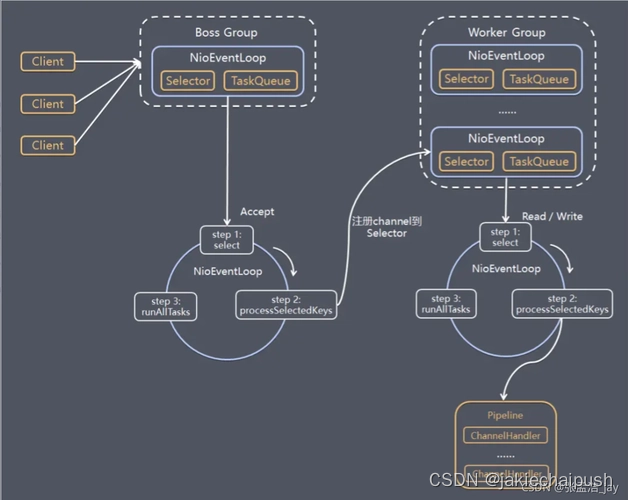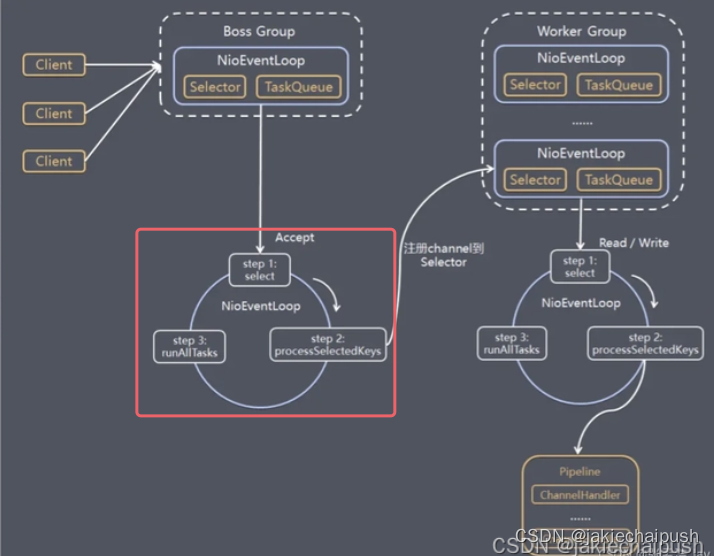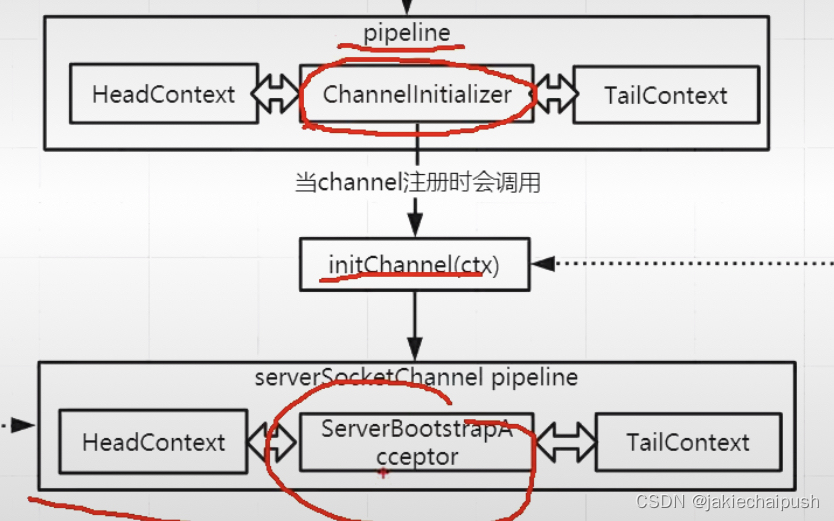文章目录
- 一、Netty线程模型简介
- 二、Netty线程模型源码分析
- 1. 服务端源码分析
一、Netty线程模型简介
Netty的线程模型图如下所示:

具体细节看这篇博客
二、Netty线程模型源码分析
1. 服务端源码分析
首先我们在写Netty服务端程序的时候最开始是下面两句代码:
//指定EvenLoopGroup中EvenLoop(线程数)的数量
EvenLoopGroup bossGroup = new NioEventLoopGroup(1);
//使用默认数量
EvenLoopGroup bossGroup = new NioEventLoopGroup();
我们进入默认构造方法:
//如果我们不传递参数,默认数就是0public NioEventLoopGroup() {this(0);}protected MultithreadEventLoopGroup(int nThreads, ThreadFactory threadFactory, Object... args) {super(nThreads == 0 ? DEFAULT_EVENT_LOOP_THREADS : nThreads, threadFactory, args);}
上面代码最核心的是super(nThreads == 0 ? DEFAULT_EVENT_LOOP_THREADS : nThreads, threadFactory, args);,这里面它判断参数传入的线程数nThreads是否为0,如果是0线程数就是默认的DEFAULT_EVENT_LOOP_THREADS,我们看看这个默认值是怎么初始化的:
private static final int DEFAULT_EVENT_LOOP_THREADS = Math.max(1, SystemPropertyUtil.getInt("io.netty.eventLoopThreads", NettyRuntime.availableProcessors() * 2));
上面代码的逻辑就是1和SystemPropertyUtil.getInt的返回值进行比较,这个方法会首先判断系统参数"io.netty.eventLoopThreads"是否配置了,配置了就用该系统参数的值,没有配置就使用NettyRuntime.availableProcessors() * 2也就是该机器核数的2倍。上面代码就设置了NioEventLoopGroup中线程数的数量。我们继续进入super方法。
protected MultithreadEventExecutorGroup(int nThreads, Executor executor, EventExecutorChooserFactory chooserFactory, Object... args) {this.terminatedChildren = new AtomicInteger();this.terminationFuture = new DefaultPromise(GlobalEventExecutor.INSTANCE);//如果参数nThreads是0,就抛出异常(前面我们已经讲解了源码中这个参数是如何设置的)if (nThreads <= 0) {throw new IllegalArgumentException(String.format("nThreads: %d (expected: > 0)", nThreads));} else {//我们知道在前面的代码中我们并没有指定线程池,这个if就是帮我们创建线程池if (executor == null) {executor = new ThreadPerTaskExecutor(this.newDefaultThreadFactory());}//这里又指定了一个线程池数组,然后数量就是参数nThreads(线程池数组)this.children = new EventExecutor[nThreads];int j;//遍历线程池数组中每一个线程池for(int i = 0; i < nThreads; ++i) {boolean success = false;boolean var18 = false;try {var18 = true;//给线程池赋值this.children[i] = this.newChild((Executor)executor, args);success = true;var18 = false;} catch (Exception var19) {throw new IllegalStateException("failed to create a child event loop", var19);} finally {if (var18) {if (!success) {int j;for(j = 0; j < i; ++j) {this.children[j].shutdownGracefully();}for(j = 0; j < i; ++j) {EventExecutor e = this.children[j];try {while(!e.isTerminated()) {e.awaitTermination(2147483647L, TimeUnit.SECONDS);}} catch (InterruptedException var20) {Thread.currentThread().interrupt();break;}}}}}if (!success) {for(j = 0; j < i; ++j) {this.children[j].shutdownGracefully();}for(j = 0; j < i; ++j) {EventExecutor e = this.children[j];try {while(!e.isTerminated()) {e.awaitTermination(2147483647L, TimeUnit.SECONDS);}} catch (InterruptedException var22) {Thread.currentThread().interrupt();break;}}}}this.chooser = chooserFactory.newChooser(this.children);FutureListener<Object> terminationListener = new FutureListener<Object>() {public void operationComplete(Future<Object> future) throws Exception {if (MultithreadEventExecutorGroup.this.terminatedChildren.incrementAndGet() == MultithreadEventExecutorGroup.this.children.length) {MultithreadEventExecutorGroup.this.terminationFuture.setSuccess((Object)null);}}};EventExecutor[] var24 = this.children;j = var24.length;for(int var26 = 0; var26 < j; ++var26) {EventExecutor e = var24[var26];e.terminationFuture().addListener(terminationListener);}Set<EventExecutor> childrenSet = new LinkedHashSet(this.children.length);Collections.addAll(childrenSet, this.children);this.readonlyChildren = Collections.unmodifiableSet(childrenSet);}}
首先我们先看上面代码的第一个核心代码:
this.children[i] = this.newChild((Executor)executor, args);//NIOEventLoopGroup的实现protected EventLoop newChild(Executor executor, Object... args) throws Exception {EventLoopTaskQueueFactory queueFactory = args.length == 4 ? (EventLoopTaskQueueFactory)args[3] : null;return new NioEventLoop(this, executor, (SelectorProvider)args[0], ((SelectStrategyFactory)args[1]).newSelectStrategy(), (RejectedExecutionHandler)args[2], queueFactory);}
从返回值我们看到类型是NioEventLoop,也就是说 this.children[i]这个线程池数组中放的是NioEventLoop对象,这也对应了线程模型图中的下面红圈部分:

我们继续进入NioEventLoop的构造函数:
NioEventLoop(NioEventLoopGroup parent, Executor executor, SelectorProvider selectorProvider, SelectStrategy strategy, RejectedExecutionHandler rejectedExecutionHandler, EventLoopTaskQueueFactory queueFactory) {super(parent, executor, false, newTaskQueue(queueFactory), newTaskQueue(queueFactory), rejectedExecutionHandler);if (selectorProvider == null) {throw new NullPointerException("selectorProvider");} else if (strategy == null) {throw new NullPointerException("selectStrategy");} else {this.provider = selectorProvider;SelectorTuple selectorTuple = this.openSelector();this.selector = selectorTuple.selector;this.unwrappedSelector = selectorTuple.unwrappedSelector;this.selectStrategy = strategy;}}
上面代码首先第一句是调用父类的构造方法:
super(parent, executor, false, newTaskQueue(queueFactory), newTaskQueue(queueFactory), rejectedExecutionHandler);protected SingleThreadEventLoop(EventLoopGroup parent, Executor executor, boolean addTaskWakesUp, Queue<Runnable> taskQueue, Queue<Runnable> tailTaskQueue, RejectedExecutionHandler rejectedExecutionHandler) {super(parent, executor, addTaskWakesUp, taskQueue, rejectedExecutionHandler);this.tailTasks = (Queue)ObjectUtil.checkNotNull(tailTaskQueue, "tailTaskQueue");}protected SingleThreadEventExecutor(EventExecutorGroup parent, Executor executor, boolean addTaskWakesUp, int maxPendingTasks, RejectedExecutionHandler rejectedHandler) {super(parent);this.threadLock = new CountDownLatch(1);this.shutdownHooks = new LinkedHashSet();this.state = 1;this.terminationFuture = new DefaultPromise(GlobalEventExecutor.INSTANCE);this.addTaskWakesUp = addTaskWakesUp;this.maxPendingTasks = Math.max(16, maxPendingTasks);this.executor = ThreadExecutorMap.apply(executor, this);//这个taskQueue的底层本质上就是一个LinkedBlockingQueue,阻塞队列this.taskQueue = this.newTaskQueue(this.maxPendingTasks);this.rejectedExecutionHandler = (RejectedExecutionHandler)ObjectUtil.checkNotNull(rejectedHandler, "rejectedHandler");}
继续回到NioEventLoop构造函数,然后是下面代码:
this.provider = selectorProvider;SelectorTuple selectorTuple = this.openSelector();this.selector = selectorTuple.selector;
上面代码逻辑其实在Java的NIO中也有,就是获取一个Selector,然后赋值给了this.selector这个Ni oEventLoop成员变量。到这里NioEventLoop的两个核心组件Selector和TaskQueue就找到源头了,我们继续回到MultithreadEventExecutorGroup方法:
this.children[i] = this.newChild((Executor)executor, args);
通过上面分析,我们知道了this.children[I]这个线程池数组里面封装的就是一个一个的NioEventLoop,然后NioEventLoop底层就是一个Selector一个TaskQueue,也正是对应了线程模型中的第一个部分,然后newChild((Executor)executor, args);这个方法的第一个参数就是executor它是我们前面创建的一个ThreadPerTaskExecutor线程池,这里先不介绍这个线程池。到此NioEventLoopGroup创建的大致的底层逻辑就分析完了,当然还有很多细节代码没有分析,这里就和后面具体的业务代码进行分析,在NioEventLoopGroup创建完成后,主程序就开始执行下面代码:
//指定EvenLoopGroup中EvenLoop(线程数)的数量
EvenLoopGroup bossGroup = new NioEventLoopGroup(1);
//使用默认数量
EvenLoopGroup bossGroup = new NioEventLoopGroup();
try{//创建服务器端的启动对象ServerBootStrap bootstrap =new ServerBootStrap();
}
点进ServerBootStrap的构造函数:
public ServerBootstrap() {}
可以发现它的构造方法中什么也没干,也就没什么逻辑分析了,继续执行主业务代码:
//指定EvenLoopGroup中EvenLoop(线程数)的数量
EvenLoopGroup bossGroup = new NioEventLoopGroup(1);
//使用默认数量
EvenLoopGroup bossGroup = new NioEventLoopGroup();
try{//创建服务器端的启动对象ServerBootStrap bootstrap =new ServerBootStrap();//使用链式编程来配置参数bootstrap.group(bossGroup,workerGroup)//设置两个线程组
}
ServerBootStrap的参数的配置通常使用链式编程的方式进行配置,首先看第一个配置.group(bossGroup,childGroup),从形式上看就是将我们前面定义的两个NiojEventLoopGroup设置进去了,我们进去源码看看:
public ServerBootstrap group(EventLoopGroup parentGroup, EventLoopGroup childGroup) {super.group(parentGroup);ObjectUtil.checkNotNull(childGroup, "childGroup");if (this.childGroup != null) {throw new IllegalStateException("childGroup set already");} else {this.childGroup = childGroup;return this;}}public B group(EventLoopGroup group) {ObjectUtil.checkNotNull(group, "group");if (this.group != null) {throw new IllegalStateException("group set already");} else {this.group = group;return this.self();}}
从参数我们可以看出bossGroup对应的是parentGroup(父线程组),workerGroup对应的是childGroup(子线程组),首先调用了 super.group(parentGroup);即父类的group方法,父类的group方法主要就是将bossGroup赋值给了this.group 成员变量,然后childGroup赋值给子类的this.childGroup成员变量,然后返回this当前对象,达到了链式调用的条件。上面代码本质上就是将我们创建的NioEventLoopGroup对象保存到了ServerBootStrap对象中。到此group(bossGroup,workerGroup)方法就执行完了,继续回到主业务代码:
//指定EvenLoopGroup中EvenLoop(线程数)的数量
EvenLoopGroup bossGroup = new NioEventLoopGroup(1);
//使用默认数量
EvenLoopGroup bossGroup = new NioEventLoopGroup();
try{//创建服务器端的启动对象ServerBootStrap bootstrap =new ServerBootStrap();//使用链式编程来配置参数bootstrap.group(bossGroup,workerGroup)//设置两个线程组.channel(NioServerSocketChannel.class) //使用NioServerSocketChannel作为服务器通道的实现
}
我们进入channel(NioServerSocketChannel.class) 方法:
public B channel(Class<? extends C> channelClass) {return this.channelFactory((io.netty.channel.ChannelFactory)(new ReflectiveChannelFactory((Class)ObjectUtil.checkNotNull(channelClass, "channelClass"))));}
按照代码逻辑就是调用了this.channelFactory函数,然后该函数的参数就是new ReflectiveChannelFactory((Class)ObjectUtil.checkNotNull(channelClass, "channelClass"))根据我们传入的channelClass类型创建了一个ReflectiveChannelFactory我们进入内部代码看看:
public ReflectiveChannelFactory(Class<? extends T> clazz) {ObjectUtil.checkNotNull(clazz, "clazz");try {//将我们传入的channel类型的构造函数暂存了起来this.constructor = clazz.getConstructor();} catch (NoSuchMethodException var3) {throw new IllegalArgumentException("Class " + StringUtil.simpleClassName(clazz) + " does not have a public non-arg constructor", var3);}}
上面方法就是将我们的指定的NioServerSocketChannel的构造函数保存到了ReflectiveChannelFactory对象中了,然后执行this.channelFactory方法,我们进入该方法:
public B channelFactory(ChannelFactory<? extends C> channelFactory) {ObjectUtil.checkNotNull(channelFactory, "channelFactory");if (this.channelFactory != null) {throw new IllegalStateException("channelFactory set already");} else {//这里就是将前面创建的channel工厂对象保存了起来this.channelFactory = channelFactory;return this.self();}}
上面代码就是将前面我们创建的ReflectiveChannelFactory保存到了 this.channelFactory这个成员变量中。然后回到主业务代码:
//指定EvenLoopGroup中EvenLoop(线程数)的数量
EvenLoopGroup bossGroup = new NioEventLoopGroup(1);
//使用默认数量
EvenLoopGroup bossGroup = new NioEventLoopGroup();
try{//创建服务器端的启动对象ServerBootStrap bootstrap =new ServerBootStrap();//使用链式编程来配置参数bootstrap.group(bossGroup,workerGroup)//设置两个线程组.channel(NioServerSocketChannel.class) //使用NioServerSocketChannel作为服务器通道的实现.option(ChannelOption.SO_BACKLOG,1024)//初始化服务器的连接队列大小,服务端处理客户端的连接是顺序处理的,所以同一事件只能处理一个客户端连接。多个客户端同时来的时候,服务端将不能处理的连接请求放在队列中等待
}
我们进入.option方法:
public <T> B option(ChannelOption<T> option, T value) {ObjectUtil.checkNotNull(option, "option");if (value == null) {this.options.remove(option);} else {this.options.put(option, value);}return this.self();}
//BootStrap中的成员变量中的一个map集合(存储netty程序员启动时需要设置的一些属性)
private final Map<ChannelOption<?>, Object> options = new ConcurrentHashMap();
option方法本质上就是用来设置Netty启动时的一些属性的,例如ChannelOption.SO_BACKLOG就是其中之一,设置的方式就是放到了ServerBootStrap中的一个线程安全集合options中。这些参数的作用后面再分析,然后继续回到业务代码:
//指定EvenLoopGroup中EvenLoop(线程数)的数量
EvenLoopGroup bossGroup = new NioEventLoopGroup(1);
//使用默认数量
EvenLoopGroup bossGroup = new NioEventLoopGroup();
try{//创建服务器端的启动对象ServerBootStrap bootstrap =new ServerBootStrap();//使用链式编程来配置参数bootstrap.group(bossGroup,workerGroup)//设置两个线程组.channel(NioServerSocketChannel.class) //使用NioServerSocketChannel作为服务器通道的实现.option(ChannelOption.SO_BACKLOG,1024)//初始化服务器的连接队列大小,服务端处理客户端的连接是顺序处理的,所以同一事件只能处理一个客户端连接。多个客户端同时来的时候,服务端将不能处理的连接请求放在队列中等待 .childHandler((ChannelInitializer)(ch)->{//对workerGroup的SocketChannel设置处理器ch.pipeline().addLast(new NettyServerHandler());});
}
然后就是调用 .childHandler设置channel的处理器链了,这也是最核心的部分了。我们进入该方法:
public ServerBootstrap childHandler(ChannelHandler childHandler) {this.childHandler = (ChannelHandler)ObjectUtil.checkNotNull(childHandler, "childHandler");return this;}
上面代码就是将ChannelHandler对象赋值给ServerBootStrap的 this.childHandler属性。
看到这里我们不难发现整个链式调用的过程其实都是在给启动器
ServerBootStrap对象的成员变量进行赋值。
到此ServerBootStrap对象就创建完成了,我们继续进行业务代码:
//指定EvenLoopGroup中EvenLoop(线程数)的数量
EvenLoopGroup bossGroup = new NioEventLoopGroup(1);
//使用默认数量
EvenLoopGroup bossGroup = new NioEventLoopGroup();
try{//创建服务器端的启动对象ServerBootStrap bootstrap =new ServerBootStrap();//使用链式编程来配置参数bootstrap.group(bossGroup,workerGroup)//设置两个线程组.channel(NioServerSocketChannel.class) //使用NioServerSocketChannel作为服务器通道的实现.option(ChannelOption.SO_BACKLOG,1024)//初始化服务器的连接队列大小,服务端处理客户端的连接是顺序处理的,所以同一事件只能处理一个客户端连接。多个客户端同时来的时候,服务端将不能处理的连接请求放在队列中等待 .childHandler((ChannelInitializer)(ch)->{//对workerGroup的SocketChannel设置处理器ch.pipeline().addLast(new NettyServerHandler());});//绑定一个端口并且同步,生成了一个ChannelFuture异步对象,通过isDone()等方法可以判断异步事件的执行情况//启动服务器并绑定端口,bind是异步操作,sync方法是等待异步操作执行完毕(阻塞的)ChannelFuture cf=bootstrap.bind(9000).sync();
}
上面的代码是非常重要的一句代码,这里我们详细分析一下,我们进入bind方法:
public ChannelFuture bind(int inetPort) {return this.bind(new InetSocketAddress(inetPort));}
上面代码首先将我们传入的端口号9000封装为一个InetSocketAddress对象,然后调用ServerBootStrap的bind方法,我们进入该bind方法:
public ChannelFuture bind(SocketAddress localAddress) {this.validate();return this.doBind((SocketAddress)ObjectUtil.checkNotNull(localAddress, "localAddress"));}
核心方法是this.doBind方法,然后参数就是我们前面传入的端口号,继续进入this.doBind方法:
private ChannelFuture doBind(final SocketAddress localAddress) {final ChannelFuture regFuture = this.initAndRegister();final Channel channel = regFuture.channel();if (regFuture.cause() != null) {return regFuture;} else if (regFuture.isDone()) {ChannelPromise promise = channel.newPromise();doBind0(regFuture, channel, localAddress, promise);return promise;} else {final PendingRegistrationPromise promise = new PendingRegistrationPromise(channel);regFuture.addListener(new ChannelFutureListener() {public void operationComplete(ChannelFuture future) throws Exception {Throwable cause = future.cause();if (cause != null) {promise.setFailure(cause);} else {promise.registered();AbstractBootstrap.doBind0(regFuture, channel, localAddress, promise);}}});return promise;}}
我们重点分析上面代码,首先第一句核心代码是 final ChannelFuture regFuture = this.initAndRegister();,它调用了this.initAndRegister方法获取了一个ChannelFuture对象,我们看看initAndRegister方法:
final ChannelFuture initAndRegister() {Channel channel = null;try {channel = this.channelFactory.newChannel();this.init(channel);} catch (Throwable var3) {if (channel != null) {channel.unsafe().closeForcibly();return (new DefaultChannelPromise(channel, GlobalEventExecutor.INSTANCE)).setFailure(var3);}return (new DefaultChannelPromise(new FailedChannel(), GlobalEventExecutor.INSTANCE)).setFailure(var3);}ChannelFuture regFuture = this.config().group().register(channel);if (regFuture.cause() != null) {if (channel.isRegistered()) {channel.close();} else {channel.unsafe().closeForcibly();}}return regFuture;}
channel = this.channelFactory.newChannel();,前面在分析ServerBootStrap对象构建过程中,分析了.channel(NioServerSocketChannel.class)底层就保存了一个channel工厂对象,这里就将前面创建的工厂对象拿出来创建了一个channel对象的实例,我们进入newChannel()方法:
public T newChannel() {try {return (Channel)this.constructor.newInstance();} catch (Throwable var2) {throw new ChannelException("Unable to create Channel from class " + this.constructor.getDeclaringClass(), var2);}}
channel工厂对象内部保存的其实就是我们传入的NioServerSocketChannel.class类型的构造函数,这里就用保存的构造函数使用反射创建了一个Channel实例。这里调用的是NioServerSocketChannel.class的空构造方法,我们进入该构造方法,看它创建了一些什么东西:
public NioServerSocketChannel() {this(newSocket(DEFAULT_SELECTOR_PROVIDER));}
然后这里调用了newSocket(DEFAULT_SELECTOR_PROVIDER)方法,我们进入该方法:
private static java.nio.channels.ServerSocketChannel newSocket(SelectorProvider provider) {try {return provider.openServerSocketChannel();} catch (IOException var2) {throw new ChannelException("Failed to open a server socket.", var2);}}
provider.openServerSocketChannel();这句代码和NIO底层的ServerSocketChannel类的open方法的代码一模一样,这句代码的作用就是,从返回值也可以看出是java.nio.channels.ServerSocketChannel,创建了一个ServerSocketChannel对象。newSocket执行完毕后,看this调用的是哪一个构造函数:
public NioServerSocketChannel(java.nio.channels.ServerSocketChannel channel) {super((Channel)null, channel, 16);this.config = new NioServerSocketChannelConfig(this, this.javaChannel().socket());}
首先我们进入super方法,参数就是前面newSocket创建的java.nio.channels.ServerSocketChannel对象,以及一个16,这个16就代表NIO中Selectionkey对象的OP_ACCEPT事件public static final int OP_ACCEPT=1<<4;:
protected AbstractNioChannel(Channel parent, SelectableChannel ch, int readInterestOp) {super(parent);//记录serverSocketChannelthis.ch = ch;//记录serverSocketChannel感兴趣的事件this.readInterestOp = readInterestOp;try {//设置channel为非阻塞模式ch.configureBlocking(false);} catch (IOException var7) {try {ch.close();} catch (IOException var6) {logger.warn("Failed to close a partially initialized socket.", var6);}throw new ChannelException("Failed to enter non-blocking mode.", var7);}}
我们继续进入super方法:
protected AbstractChannel(Channel parent) {this.parent = parent;this.id = this.newId();this.unsafe = this.newUnsafe();this.pipeline = this.newChannelPipeline();}
上面代码核心就是创建了this.pipeline对象,我们进入newChannelPipeline方法,看看底层是如何创建Pipeline的:
protected DefaultChannelPipeline newChannelPipeline() {return new DefaultChannelPipeline(this);}protected DefaultChannelPipeline(Channel channel) {this.channel = (Channel)ObjectUtil.checkNotNull(channel, "channel");this.succeededFuture = new SucceededChannelFuture(channel, (EventExecutor)null);this.voidPromise = new VoidChannelPromise(channel, true);//默认放了一个尾节点this.tail = new TailContext(this);//默认放了一个头节点this.head = new HeadContext(this);//说明是一个双向链表this.head.next = this.tail;this.tail.prev = this.head;}
从上面的代码我们就可以看出了ChannelPipeline的底层结构了:

到此channelFactory.newChannel底层的逻辑我们就看完了,其实就是创建了一个ServerSocketChannel,然后构建了pipeline对象,我们继续回到initAndRegister()方法:
final ChannelFuture initAndRegister() {Channel channel = null;try {channel = this.channelFactory.newChannel();this.init(channel);} catch (Throwable var3) {if (channel != null) {channel.unsafe().closeForcibly();return (new DefaultChannelPromise(channel, GlobalEventExecutor.INSTANCE)).setFailure(var3);}return (new DefaultChannelPromise(new FailedChannel(), GlobalEventExecutor.INSTANCE)).setFailure(var3);}ChannelFuture regFuture = this.config().group().register(channel);if (regFuture.cause() != null) {if (channel.isRegistered()) {channel.close();} else {channel.unsafe().closeForcibly();}}return regFuture;}
然后就行调用 this.init(channel);方法,我们进入该方法:
//参数就是前面创建的NioServerSocketChannel对象
void init(Channel channel) {setChannelOptions(channel, (Map.Entry[])this.options0().entrySet().toArray(newOptionArray(0)), logger);setAttributes(channel, (Map.Entry[])this.attrs0().entrySet().toArray(newAttrArray(0)));ChannelPipeline p = channel.pipeline();final EventLoopGroup currentChildGroup = this.childGroup;final ChannelHandler currentChildHandler = this.childHandler;final Map.Entry<ChannelOption<?>, Object>[] currentChildOptions = (Map.Entry[])this.childOptions.entrySet().toArray(newOptionArray(0));final Map.Entry<AttributeKey<?>, Object>[] currentChildAttrs = (Map.Entry[])this.childAttrs.entrySet().toArray(newAttrArray(0));p.addLast(new ChannelHandler[]{new ChannelInitializer<Channel>() {public void initChannel(final Channel ch) {//拿到前面创建的管道final ChannelPipeline pipeline = ch.pipeline();ChannelHandler handler = ServerBootstrap.this.config.handler();if (handler != null) {pipeline.addLast(new ChannelHandler[]{handler});}ch.eventLoop().execute(new Runnable() {public void run() {pipeline.addLast(new ChannelHandler[]{new ServerBootstrapAcceptor(ch, currentChildGroup, currentChildHandler, currentChildOptions, currentChildAttrs)});}});}}});}
上面代码最核心的一部分是下面这一段代码:
p.addLast(new ChannelHandler[]{new ChannelInitializer<Channel>() {public void initChannel(final Channel ch) {final ChannelPipeline pipeline = ch.pipeline();ChannelHandler handler = ServerBootstrap.this.config.handler();if (handler != null) {pipeline.addLast(new ChannelHandler[]{handler});}ch.eventLoop().execute(new Runnable() {public void run() {pipeline.addLast(new ChannelHandler[]{new ServerBootstrapAcceptor(ch, currentChildGroup, currentChildHandler, currentChildOptions, currentChildAttrs)});}});}}});
使用netty的都知道这个就是向管道(ServerSocketChannel)中加入了一个处理器handler,这个handler的作用我们后面再分析,现在pipeline里面有三个handler了。到此init方法执行完毕了,继续回到initAndRegister方法。
final ChannelFuture initAndRegister() {Channel channel = null;try {channel = this.channelFactory.newChannel();this.init(channel);} catch (Throwable var3) {if (channel != null) {channel.unsafe().closeForcibly();return (new DefaultChannelPromise(channel, GlobalEventExecutor.INSTANCE)).setFailure(var3);}return (new DefaultChannelPromise(new FailedChannel(), GlobalEventExecutor.INSTANCE)).setFailure(var3);}ChannelFuture regFuture = this.config().group().register(channel);if (regFuture.cause() != null) {if (channel.isRegistered()) {channel.close();} else {channel.unsafe().closeForcibly();}}return regFuture;}
然后下一句核心代码是ChannelFuture regFuture = this.config().group().register(channel);,签名我们的ServerSocketChannel已经创建完了,但是按照NIO的逻辑,Channel需要注册到Selector中与感兴趣的事件绑定,这句代码就在干这个事,我们进入该方法:
config返回ServerBootStrap对象,group返回EventLoopGroup对象(注意这个EventLoopGroup是bossGroup)
//注意前面group返回的事EventLoopGroup对象,所以这个register的实现就是`MultiThreadEventLoopGroup`public ChannelFuture register(Channel channel) {return this.next().register(channel);}
注意:上面源码本人忘记下载了,看的全是Class文件,但是代码的主体结构还是大差不差,可以对照着看
next方法就是获取下一个EventLoop对象,然后调用EventLoop对象的register方法:
//注意此时调用register方法的是`EventLoop`对象,所以register方法的实现是`SingleThreadEventLoopGroup`@Overridepublic ChannelFuture register(Channel channel) {return register(new DefaultChannelPromise(channel, this));}
@Overridepublic ChannelFuture register(final ChannelPromise promise) {ObjectUtil.checkNotNull(promise, "promise");promise.channel().unsafe().register(this, promise);return promise;}@Overridepublic final void register(EventLoop eventLoop, final ChannelPromise promise) {if (eventLoop == null) {throw new NullPointerException("eventLoop");}if (isRegistered()) {promise.setFailure(new IllegalStateException("registered to an event loop already"));return;}if (!isCompatible(eventLoop)) {promise.setFailure(new IllegalStateException("incompatible event loop type: " + eventLoop.getClass().getName()));return;}AbstractChannel.this.eventLoop = eventLoop;//判断你传入的线程和当前的线程是否是一样if (eventLoop.inEventLoop()) {//如果是一样,直接调用register0register0(promise);} else {try {//否则使用你传入的线程来执行任务(这里就实现了异步调用)eventLoop.execute(new Runnable() {@Overridepublic void run() {register0(promise);}});} catch (Throwable t) {logger.warn("Force-closing a channel whose registration task was not accepted by an event loop: {}",AbstractChannel.this, t);closeForcibly();closeFuture.setClosed();safeSetFailure(promise, t);}}}
上面代码的核心部分是:
//判断你传入的线程和当前的线程是否是一样if (eventLoop.inEventLoop()) {//如果是一样,直接调用register0register0(promise);} else {try {//否则使用你传入的线程来执行任务(这里就实现了异步调用)eventLoop.execute(new Runnable() {@Overridepublic void run() {register0(promise);}});}
netty异步调用逻辑的核心代码就在try语句块中,我们进入execute方法:
@Overridepublic void execute(Runnable task) {if (task == null) {throw new NullPointerException("task");}boolean inEventLoop = inEventLoop();//将我们前面传的Runnable任务添加到了队列中addTask(task);if (!inEventLoop) {startThread();if (isShutdown()) {boolean reject = false;try {if (removeTask(task)) {reject = true;}} catch (UnsupportedOperationException e) {// The task queue does not support removal so the best thing we can do is to just move on and// hope we will be able to pick-up the task before its completely terminated.// In worst case we will log on termination.}if (reject) {reject();}}}if (!addTaskWakesUp && wakesUpForTask(task)) {wakeup(inEventLoop);}}
上面代码的核心就是addTask(task);,它将前面传的Runnable任务添加到了队列中(EventLoop的TaskQueue)。
protected void addTask(Runnable task) {if (task == null) {throw new NullPointerException("task");}if (!offerTask(task)) {reject(task);}}final boolean offerTask(Runnable task) {if (isShutdown()) {reject();}return taskQueue.offer(task);}
回到execute方法,将任务丢到队列后,下面就调用 startThread();,启动线程了,我们进入该方法:
private void startThread() {if (state == ST_NOT_STARTED) {if (STATE_UPDATER.compareAndSet(this, ST_NOT_STARTED, ST_STARTED)) {boolean success = false;try {doStartThread();success = true;} finally {if (!success) {STATE_UPDATER.compareAndSet(this, ST_STARTED, ST_NOT_STARTED);}}}}}private void doStartThread() {assert thread == null;//executor就是在创建EventLoopGroup时候创建的那个单线程线程池executor.execute(new Runnable() {@Overridepublic void run() {thread = Thread.currentThread();if (interrupted) {thread.interrupt();}boolean success = false;updateLastExecutionTime();try {SingleThreadEventExecutor.this.run();success = true;} catch (Throwable t) {logger.warn("Unexpected exception from an event executor: ", t);} finally {for (;;) {int oldState = state;if (oldState >= ST_SHUTTING_DOWN || STATE_UPDATER.compareAndSet(SingleThreadEventExecutor.this, oldState, ST_SHUTTING_DOWN)) {break;}}// Check if confirmShutdown() was called at the end of the loop.if (success && gracefulShutdownStartTime == 0) {if (logger.isErrorEnabled()) {logger.error("Buggy " + EventExecutor.class.getSimpleName() + " implementation; " +SingleThreadEventExecutor.class.getSimpleName() + ".confirmShutdown() must " +"be called before run() implementation terminates.");}}try {// Run all remaining tasks and shutdown hooks.for (;;) {if (confirmShutdown()) {break;}}} finally {try {cleanup();} finally {// Lets remove all FastThreadLocals for the Thread as we are about to terminate and notify// the future. The user may block on the future and once it unblocks the JVM may terminate// and start unloading classes.// See https://github.com/netty/netty/issues/6596.FastThreadLocal.removeAll();STATE_UPDATER.set(SingleThreadEventExecutor.this, ST_TERMINATED);threadLock.countDown();if (logger.isWarnEnabled() && !taskQueue.isEmpty()) {logger.warn("An event executor terminated with " +"non-empty task queue (" + taskQueue.size() + ')');}terminationFuture.setSuccess(null);}}}}});}
我们进入核心代码 SingleThreadEventExecutor.this.run();:
@Overrideprotected void run() {//死循环for (;;) {try {try {switch (selectStrategy.calculateStrategy(selectNowSupplier, hasTasks())) {case SelectStrategy.CONTINUE:continue;case SelectStrategy.BUSY_WAIT:// fall-through to SELECT since the busy-wait is not supported with NIOcase SelectStrategy.SELECT:select(wakenUp.getAndSet(false));if (wakenUp.get()) {selector.wakeup();}// fall throughdefault:}} catch (IOException e) {// If we receive an IOException here its because the Selector is messed up. Let's rebuild// the selector and retry. https://github.com/netty/netty/issues/8566rebuildSelector0();handleLoopException(e);continue;}cancelledKeys = 0;needsToSelectAgain = false;final int ioRatio = this.ioRatio;if (ioRatio == 100) {try {processSelectedKeys();} finally {// Ensure we always run tasks.runAllTasks();}} else {final long ioStartTime = System.nanoTime();try {processSelectedKeys();} finally {// Ensure we always run tasks.final long ioTime = System.nanoTime() - ioStartTime;runAllTasks(ioTime * (100 - ioRatio) / ioRatio);}}} catch (Throwable t) {handleLoopException(t);}// Always handle shutdown even if the loop processing threw an exception.try {if (isShuttingDown()) {closeAll();if (confirmShutdown()) {return;}}} catch (Throwable t) {handleLoopException(t);}}}
上面代码的核心就是 select(wakenUp.getAndSet(false));方法,我们进入该方法:
private void select(boolean oldWakenUp) throws IOException {//获得了selectorSelector selector = this.selector;try {int selectCnt = 0;long currentTimeNanos = System.nanoTime();long selectDeadLineNanos = currentTimeNanos + delayNanos(currentTimeNanos);long normalizedDeadlineNanos = selectDeadLineNanos - initialNanoTime();if (nextWakeupTime != normalizedDeadlineNanos) {nextWakeupTime = normalizedDeadlineNanos;}for (;;) {long timeoutMillis = (selectDeadLineNanos - currentTimeNanos + 500000L) / 1000000L;if (timeoutMillis <= 0) {if (selectCnt == 0) {selector.selectNow();selectCnt = 1;}break;}// If a task was submitted when wakenUp value was true, the task didn't get a chance to call// Selector#wakeup. So we need to check task queue again before executing select operation.// If we don't, the task might be pended until select operation was timed out.// It might be pended until idle timeout if IdleStateHandler existed in pipeline.if (hasTasks() && wakenUp.compareAndSet(false, true)) {selector.selectNow();selectCnt = 1;break;}int selectedKeys = selector.select(timeoutMillis);selectCnt ++;if (selectedKeys != 0 || oldWakenUp || wakenUp.get() || hasTasks() || hasScheduledTasks()) {// - Selected something,// - waken up by user, or// - the task queue has a pending task.// - a scheduled task is ready for processingbreak;}if (Thread.interrupted()) {// Thread was interrupted so reset selected keys and break so we not run into a busy loop.// As this is most likely a bug in the handler of the user or it's client library we will// also log it.//// See https://github.com/netty/netty/issues/2426if (logger.isDebugEnabled()) {logger.debug("Selector.select() returned prematurely because " +"Thread.currentThread().interrupt() was called. Use " +"NioEventLoop.shutdownGracefully() to shutdown the NioEventLoop.");}selectCnt = 1;break;}long time = System.nanoTime();if (time - TimeUnit.MILLISECONDS.toNanos(timeoutMillis) >= currentTimeNanos) {// timeoutMillis elapsed without anything selected.selectCnt = 1;} else if (SELECTOR_AUTO_REBUILD_THRESHOLD > 0 &&selectCnt >= SELECTOR_AUTO_REBUILD_THRESHOLD) {// The code exists in an extra method to ensure the method is not too big to inline as this// branch is not very likely to get hit very frequently.selector = selectRebuildSelector(selectCnt);selectCnt = 1;break;}currentTimeNanos = time;}if (selectCnt > MIN_PREMATURE_SELECTOR_RETURNS) {if (logger.isDebugEnabled()) {logger.debug("Selector.select() returned prematurely {} times in a row for Selector {}.",selectCnt - 1, selector);}}} catch (CancelledKeyException e) {if (logger.isDebugEnabled()) {logger.debug(CancelledKeyException.class.getSimpleName() + " raised by a Selector {} - JDK bug?",selector, e);}// Harmless exception - log anyway}}
上面代码的核心代码就是int selectedKeys = selector.select(timeoutMillis);,这里就调用了Selector的select方法,学习NIO后我们知道这个方法是一个阻塞方法,方法结果的返回值就是已经就绪的事件。这里设置了超时时间,到了超时时间不管有没有事件就绪,select方法就会执行完毕。上面代码核心就是调用了一个select方法,回到run方法:
if (ioRatio == 100) {try {processSelectedKeys();} finally {// Ensure we always run tasks.runAllTasks();}}
回到线程模型图,我们就回到了下面红圈部分:

第二步就是调用processSelectedKeys()方法,我们进入该方法:
private void processSelectedKeys() {if (selectedKeys != null) {processSelectedKeysOptimized();} else {processSelectedKeysPlain(selector.selectedKeys());}}
如果selectedKeys不为空,进入processSelectedKeysOptimized方法:
private void processSelectedKeysOptimized() {for (int i = 0; i < selectedKeys.size; ++i) {final SelectionKey k = selectedKeys.keys[i];// null out entry in the array to allow to have it GC'ed once the Channel close// See https://github.com/netty/netty/issues/2363selectedKeys.keys[i] = null;final Object a = k.attachment();if (a instanceof AbstractNioChannel) {processSelectedKey(k, (AbstractNioChannel) a);} else {@SuppressWarnings("unchecked")NioTask<SelectableChannel> task = (NioTask<SelectableChannel>) a;processSelectedKey(k, task);}if (needsToSelectAgain) {// null out entries in the array to allow to have it GC'ed once the Channel close// See https://github.com/netty/netty/issues/2363selectedKeys.reset(i + 1);selectAgain();i = -1;}}}
上面核心代码就是NIO代码的逻辑,这里就不详细分析了。回到run方法,下面就会调用runAllTasks()方法:
protected boolean runAllTasks() {assert inEventLoop();boolean fetchedAll;boolean ranAtLeastOne = false;do {fetchedAll = fetchFromScheduledTaskQueue();if (runAllTasksFrom(taskQueue)) {ranAtLeastOne = true;}} while (!fetchedAll); // keep on processing until we fetched all scheduled tasks.if (ranAtLeastOne) {lastExecutionTime = ScheduledFutureTask.nanoTime();}afterRunningAllTasks();return ranAtLeastOne;}
上面代码就是将EventLoop的TaskQueue中的任务拿出来执行。这里我们就得回到前面的register方法,因为在这里我们加入的一个任务会在runAllTasks方法中执行:
eventLoop.execute(new Runnable() {@Overridepublic void run() {register0(promise);}});
我们进入register0方法:
private void register0(ChannelPromise promise) {try {// check if the channel is still open as it could be closed in the mean time when the register// call was outside of the eventLoopif (!promise.setUncancellable() || !ensureOpen(promise)) {return;}boolean firstRegistration = neverRegistered;doRegister();neverRegistered = false;registered = true;// Ensure we call handlerAdded(...) before we actually notify the promise. This is needed as the// user may already fire events through the pipeline in the ChannelFutureListener.pipeline.invokeHandlerAddedIfNeeded();safeSetSuccess(promise);pipeline.fireChannelRegistered();// Only fire a channelActive if the channel has never been registered. This prevents firing// multiple channel actives if the channel is deregistered and re-registered.if (isActive()) {if (firstRegistration) {pipeline.fireChannelActive();} else if (config().isAutoRead()) {beginRead();}}} catch (Throwable t) {// Close the channel directly to avoid FD leak.closeForcibly();closeFuture.setClosed();safeSetFailure(promise, t);}}
注意上面代码第一个十分核心的代码 doRegister();,我们进入该方法:
@Overrideprotected void doRegister() throws Exception {boolean selected = false;for (;;) {try {selectionKey = javaChannel().register(eventLoop().unwrappedSelector(), 0, this);return;} catch (CancelledKeyException e) {if (!selected) {// Force the Selector to select now as the "canceled" SelectionKey may still be// cached and not removed because no Select.select(..) operation was called yet.eventLoop().selectNow();selected = true;} else {// We forced a select operation on the selector before but the SelectionKey is still cached// for whatever reason. JDK bug ?throw e;}}}}
javaChannel()就是前面创建的ServerSocketChannel,然后调用register方法将ServerSocketChannel注册到了Selector中了,然后绑定了感兴趣的事件。这里也是NIO的逻辑。回到register0方法,下一个核心代码是:
pipeline.invokeHandlerAddedIfNeeded();safeSetSuccess(promise);pipeline.fireChannelRegistered();// Only fire a channelActive if the channel has never been registered. This prevents firing// multiple channel actives if the channel is deregistered and re-registered.if (isActive()) {if (firstRegistration) {pipeline.fireChannelActive();} else if (config().isAutoRead()) {beginRead();}}
invokeHandlerAddedIfNeeded();这里底层源码比较复杂,它底层其实会调用我们之前在初始化pipeLine的时候加入的一个handler:
p.addLast(new ChannelHandler[]{new ChannelInitializer<Channel>() {public void initChannel(final Channel ch) {final ChannelPipeline pipeline = ch.pipeline();ChannelHandler handler = ServerBootstrap.this.config.handler();if (handler != null) {pipeline.addLast(new ChannelHandler[]{handler});}ch.eventLoop().execute(new Runnable() {public void run() {pipeline.addLast(new ChannelHandler[]{new ServerBootstrapAcceptor(ch, currentChildGroup, currentChildHandler, currentChildOptions, currentChildAttrs)});}});}}});
执行了上面的代码PipeLine里面的handler的情况变化如下:

继续执行下面代码:
pipeline.fireChannelRegistered();//head就是前面双向链表的头节点@Overridepublic final ChannelPipeline fireChannelRegistered() {AbstractChannelHandlerContext.invokeChannelRegistered(head);return this;}static void invokeChannelRegistered(final AbstractChannelHandlerContext next) {EventExecutor executor = next.executor();if (executor.inEventLoop()) {//同步方式调用next.invokeChannelRegistered();} else {//异步方式调用executor.execute(new Runnable() {@Overridepublic void run() {next.invokeChannelRegistered();}});}}private void invokeChannelRegistered() {if (invokeHandler()) {try {((ChannelInboundHandler) handler()).channelRegistered(this);} catch (Throwable t) {notifyHandlerException(t);}} else {fireChannelRegistered();}}//AbstractRemoteAddressFilter@Overridepublic void channelRegistered(ChannelHandlerContext ctx) throws Exception {handleNewChannel(ctx);ctx.fireChannelRegistered();}
((ChannelInboundHandler) handler()).channelRegistered(this);就调用了handler的channelRegistered方法,然后ctx.fireChannelRegistered();就是调用pipeline中下一个handler的核心逻辑。
上面就介绍了ServerBootStrap启动的核心逻辑。

)




)




——更新中)

详解)



)

